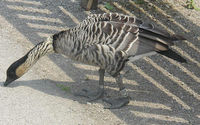Hawaiian Goose
Conservation status: Vulnerable |

|
|
Scientific classification |
| Kingdom: |
Animalia
|
| Phylum: |
Chordata
|
| Class: |
Aves
|
| Order: |
Anseriformes
|
| Family: |
Anatidae
|
| Genus: |
Branta
|
| Species: |
B. sandvicensis
|
|
|
Binomial name |
Branta sandvicensis
(Vigors, 1833) |
The Hawaiian Goose or Nēnē, Branta
sandvicensis, is a
species of
goose
endemic to the
Hawaiian Islands. It shares a recent common ancestor
with Branta canadensis, the
Canada Goose. The official bird of the
State of Hawaiʻi, the Nēnē is exclusively found in the wild
of the islands of Mauʻi, Kauaʻi and Hawaiʻi. A larger,
extinct and possibly flightless species, the Nēnē-nui (Branta hylobadistes) was present in
prehistoric times on Maui; related, but hitherto undescribed
forms also occurred on Kauaʻi
and
Oʻahu, and there
was a gigantic, flightless relative on the island of Hawaiʻi.
The Nēnē gets its
Hawaiian name from its soft call.
The species has a black head, buff cheeks and heavily
furrowed neck. Bill, legs and feet are black. The young
birds are as the male but duller brown and with less
demarcation between the colours of the head and neck, and
striping and barring effects are much reduced. Bill, legs
and feet as for the adult.
The female Hawaiian Goose is similar to the male in
colouring but slightly smaller.
Its strong toes have much reduced webbing, an adaptation
to the lava flows on which it breeds. It mates on land
unlike most other wildfowl.
This is the world's rarest goose. Once common, hunting
and introduced predators such as mongooses, pigs,
and
cats reduced the population to 30 birds by 1952.
However, this species breeds well in captivity, and has been
successfully re-introduced so in 2004 it was estimated that
there were 500 birds in the wild (and good numbers in
wildfowl collections).
The distinctive neck pattern
|
A group of Nēnē; the bird on the right shows
the characteristic foot
|
A sign in Hawaiʻi
warning of crossing Nēnē.
|
Two Nēnē at the Kīlauea Point
National Wildlife Refuge.
|
References
- BirdLife International (2004).
Branta sandvicensis. 2006
IUCN Red List of Threatened Species. IUCN 2006. Retrieved on 11 May 2006. Database entry
includes justification for why this species is
vulnerable




